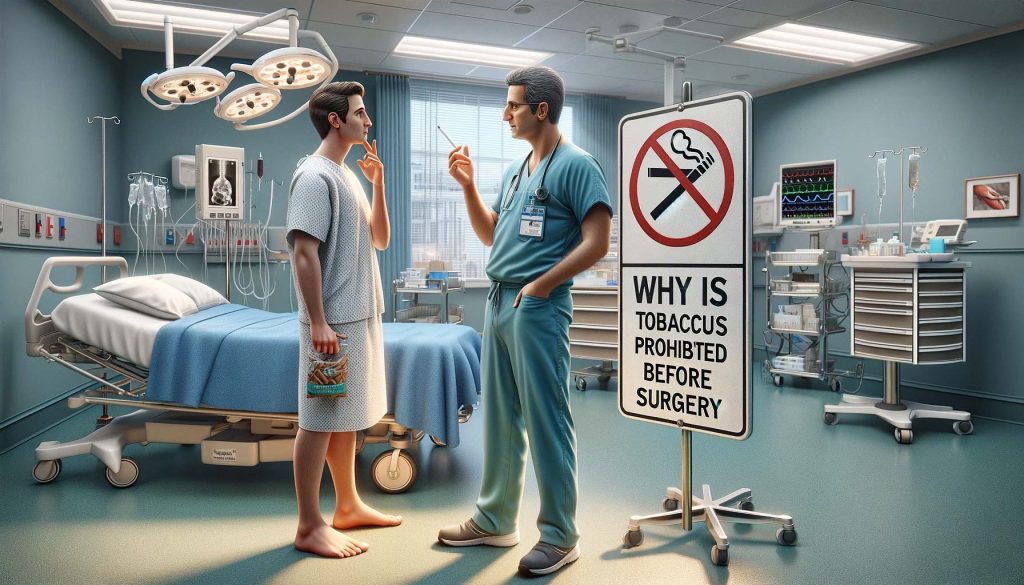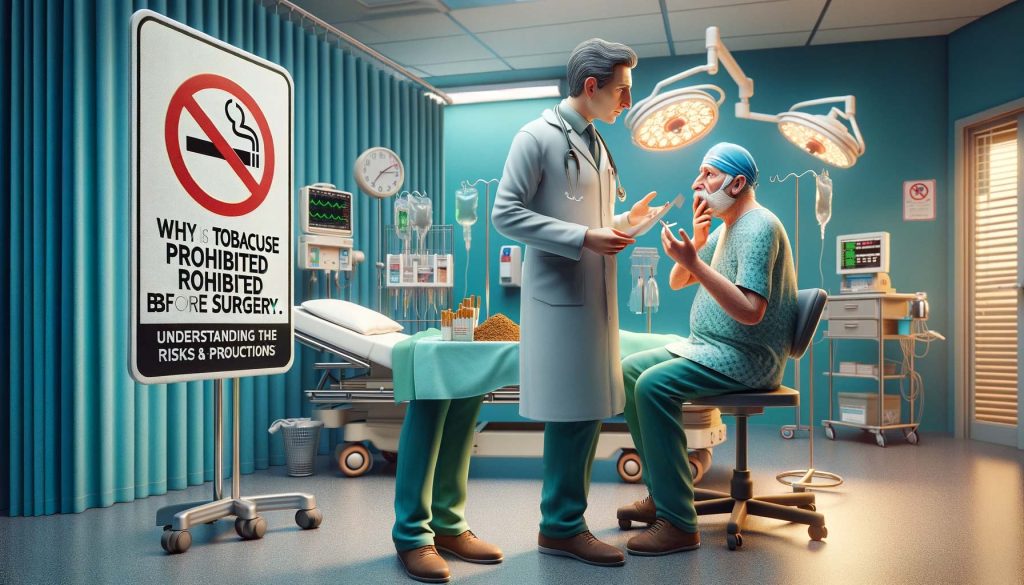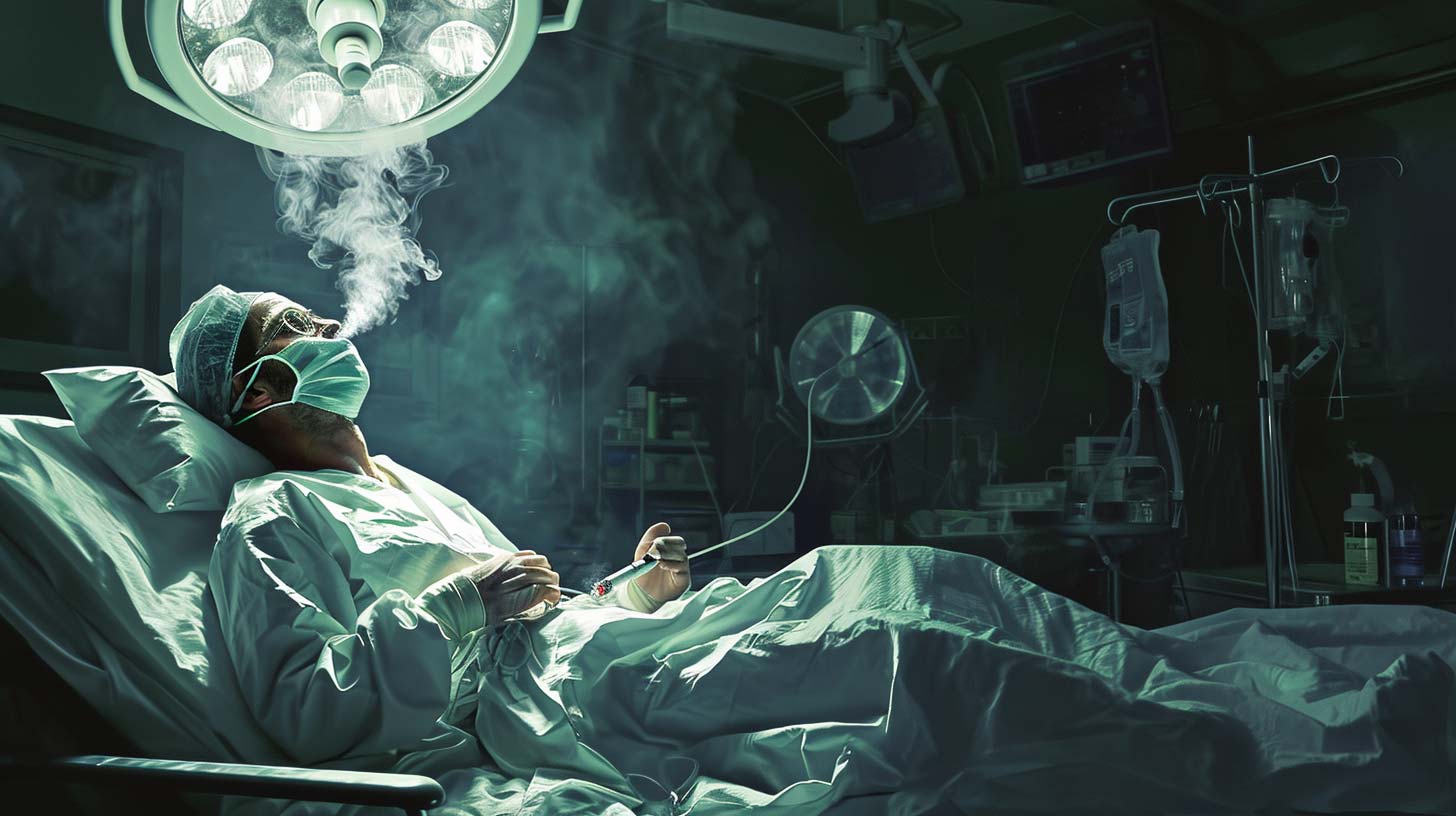Introduction
Navigating the labyrinthine realm of surgical preparations, an intricate web of enigmatic directives entwines the unsuspecting patient, with the ceaseless admonition echoing: abandon the comfort of tobacco’s embrace. In the perplexing ballet of pre-surgery rituals, a symphony of inscrutable guidelines orchestrates an otherworldly dance, and amongst these cryptic choreographies, the seemingly arbitrary prescription of smoking emerges as a mysterious protagonist. This enigma shrouds itself in the cloak of medical wisdom, beckoning us to unravel the esoteric rationale behind the prohibition. As we venture into the arcane corridors of surgical lore, the quest for comprehension becomes a peculiar business, where the currency is not mere coinage but the profound exchange of corporeal uncertainties for the tantalizing promise of smoke-free salvation on the surgical precipice.
The Impact of Tobacco on the Cardiovascular System
In the intricate tapestry of physiological intricacies, tobacco use emerges as a malevolent puppeteer, masterfully manipulating the cardiovascular symphony. The insidious choreography unfolds with nicotine, an ominous marionette, orchestrating the body’s release of adrenaline, an unholy overture that accelerates heart rate and elevates blood pressure. This macabre dance, though seemingly mundane, unveils its treacherous allure during the delicate ballet of surgery, where the heart, burdened by these nicotine-induced convulsions, must navigate an unnerving labyrinth of heightened stress. Yet, the theatre of vascular malevolence doesn’t conclude there; the shadow of tobacco casts a long pall over arterial corridors, fostering the clandestine accumulation of plaque, a sinister sediment that amplifies the specter of blockages and heart disease. As the surgeon grapples with the intricate choreography of incisions, the unseen consequences of tobacco’s perfidious pas de deux threaten to plunge the surgical narrative into a perilous abyss, where the dance of life hangs precariously in the balance.

Respiratory Complications from Smoking
In the somber saga of pulmonary perdition, smoking emerges as the nefarious architect, wielding its destructive arsenal against the delicate tapestry of lung resilience. A malevolent virtuoso, it orchestrates a symphony of devastation, with air sacs, airways, and lung linings bearing the brunt of its insidious composition. The mysterious result: a dissonant cacophony of impaired lung function, a labyrinthine maze where oxygen’s passage falters. As the surgical curtain rises, the repercussions of this pulmonary malevolence become glaringly evident, casting a foreboding shadow over the delicate choreography of the operating theater. Reduced oxygen intake, the haunting refrain of the smoker’s respiratory elegy, becomes a harbinger of dire consequences—compromised tissue oxygenation and the looming specter of postoperative respiratory tribulations. The toll doesn’t end at the operation’s curtain call; smokers, ensnared in the tendrils of their self-inflicted affliction, traverse a treacherous aftermath, marked by an elevated susceptibility to pneumonia and the ominous specter of lung infections that linger in the operatic aftermath of surgical endeavor.
Delayed Wound Healing and Infection Risks
In the cryptic dance of physiological restoration, tobacco materializes as a malevolent saboteur, clandestinely disrupting the intricate ballet of the body’s curative choreography. With its insidious chemical concoction, tobacco unveils its dark alchemy, insidiously diminishing the blood’s oxygen-carrying prowess—a vital elixir for the sacred act of wound healing. The smoker, ensnared in this perfidious embrace, becomes a reluctant participant in a protracted saga of convalescence. Wound healing, once an orchestrated symphony, descends into a dissonant melody, marked by the languorous pace of recuperation. As the surgical narrative unfolds, this decelerated healing tempo unveils itself as a harbinger of prolonged convalescence, a temporal abyss where the risk of infection at the surgical site looms ominously. The surgeon, navigating the labyrinth of tissue repair, finds the operatic rhythm disrupted, particularly in the intricate ballets of surgeries entailing substantial tissue trauma or reconstruction. The echoes of tobacco’s interlude persist, resonating in the prolonged intermission of recovery, where the lingering shadows of prolonged convalescence stifle the body’s healing encore.
Anesthetic Considerations and Tobacco Use
In the intricate dance between body and anesthesia, smoking emerges as a capricious choreographer, introducing discordant notes to the delicate symphony of drug metabolism. Nicotine, the elusive maestro, takes center stage, orchestrating a metabolic upheaval that demands the anesthesiologist’s nuanced attention. The shadow of tobacco extends beyond the ethereal veil of smoke, infiltrating the very metabolism of drugs, necessitating a delicate recalibration of anesthetic dosages. The smoker, unwittingly ensnared in this biochemical ballet, becomes a variable tempo in the anesthetic composition, demanding the conductor’s astute adjustments. Yet, the odyssey doesn’t conclude with the pharmacological overture; smokers, marked by the capricious influence of nicotine, unfurl an additional challenge—increased airway reactivity. In the operatic expanse of surgery, where the management of the airway is a delicate ballet, the smoker’s heightened reactivity becomes a narrative twist, a challenge for the anesthesiologist navigating the labyrinthine corridors of intubation. Thus, the anesthetic saga for smokers unfolds as a tale of meticulous consideration, a narrative where the anesthesiologist, armed with the awareness of nicotine’s influence, endeavors to orchestrate a harmonious administration, ensuring the safety of the smoker amid the complex interplay of anesthesia and tobacco-induced idiosyncrasies.
Nicotine’s Effect on Blood Flow and Oxygenation
In the intricate ballet of vascular dynamics, nicotine emerges as a malevolent choreographer, compelling blood vessels into a disquieting pas de deux of vasoconstriction—a relentless narrowing that throttles the vital lifelines coursing through the body. This clandestine dance, unveiled by the insidious influence of nicotine, becomes a sinister overture in the surgical symphony where blood flow is the orchestrator of tissue repair and healing. The smoker, unwittingly enmeshed in this vascular tapestry, becomes a participant in a narrative fraught with peril. As the surgeon’s hands deftly navigate the anatomical stage, the repercussions of nicotine’s vasoconstrictive interlude become starkly evident—a diminished blood flow, a constricted channel for oxygen delivery, casting a foreboding shadow over the hallowed ground of tissue repair. Reduced oxygenation, the ominous undertone of this vascular malevolence, paves the way for a litany of complications: tissues teetering on the precipice of necrosis, wounds languishing in the twilight zone of delayed healing. The surgical odyssey, already laden with complexity, becomes a precarious dance where the consequences of nicotine’s vascular choreography unfurl as a cautionary tale, urging an awareness of the treacherous impact on blood flow, an essential symphony for the orchestration of surgical outcomes.
The Role of Smoking in Post-Surgical Complications
In the post-surgical narrative, smokers find themselves ensnared in the intricate web of heightened peril, where the pall of tobacco smoke casts a lingering shadow on the trajectory of recovery. A compendium of studies, like ethereal specters, materialize to reveal the unsettling truth: smoking, that insidious accomplice, amplifies the specter of complications, transforming the postoperative landscape into treacherous terrain. The smoker, unwittingly tethered to heightened risk, navigates the aftermath where the stakes are steep and the consequences profound. The litany of potential complications reads like a macabre script blood clots, heart attacks, and strokes, orchestrated by the malevolent influence of tobacco. Deep vein thrombosis (DVT), a haunting protagonist in this surgical drama, emerges as a recurrent motif, its sinister presence accentuated by the diminished blood flow and the ominous thickening of blood viscosity induced by smoking. The post-surgical odyssey for smokers becomes a difficult journey, where the echoes of tobacco’s alliance with complications resonate, compelling a sobering recognition of the elevated risks that linger in the aftermath of surgery, an indelible mark left by the covert partnership between smoking and postoperative perils.



Recommendations for Quitting Before Surgery
In the intricate dance of surgical preparation, a temporal interlude takes center stage—quitting smoking, an ephemeral but transformative prelude that holds the promise of altering the very fabric of surgical outcomes. A harmonious consensus among health professionals underscores the profound impact of this cessation, advocating for a hiatus from tobacco’s clutches weeks before the surgical curtain rises. This temporal reprieve is not merely a pause; it becomes a gestation period, a span wherein the body, liberated from the shackles of smoke, embarks on a reparative journey. The cessation, a therapeutic overture, paves the way for improved surgical outcomes, heralding a narrative where the body’s resilience is rekindled in the absence of smoke-induced affliction. The orchestration of this cessation symphony is multifaceted, with cessation aids standing as virtuoso instruments—nicotine patches, counseling, and medication converging in a harmonious ensemble to support the aspiring non-smoker. As the patient, enshrouded in the transformative cocoon of cessation, embraces the preoperative period with newfound resolve, the surgical landscape unfolds with the promise of enhanced healing, reduced complications, and a testament to the profound impact of a temporary but monumental act—quitting smoking.
The Long-Term Benefits of Quitting Smoking Post-Surgery
In the symphony of long-term health, the decision to quit smoking emerges as a virtuoso’s crescendo, echoing through the corridors of time with a resonance that transcends the immediate surgical epoch. This cessation heralds a profound metamorphosis, a departure from the shadows of tobacco’s influence into a realm where the body unfurls its latent resilience. The cessation’s reverberations manifest as an opulent tapestry of health benefits, wherein the risk-laden chords of heart disease, lung cancer, and chronic obstructive pulmonary disease (COPD) fade into a muted melody. Post-surgery, the decision to sever ties with smoking becomes a pivotal act, a commitment to the body’s reparative harmony. In this postoperative epoch, the smoker-turned-quitter embraces a narrative of enhanced recovery—wound healing, once hindered by smoke-induced impediments, quickens its pace; the specter of infection diminishes, as the immune system, unburdened by tobacco’s shackles, emerges as a stalwart guardian. The cessation, a resounding finale to the symphony of surgical preparation, sets the stage for an overarching narrative of enduring health, where the echoes of quitting smoking reverberate as a triumphant refrain, underscoring a life liberated from the pall of tobacco’s long shadows.
Conclusion
In the intricate dance of surgical preparation, knowledge becomes the compass guiding both patients and healthcare providers through the labyrinth of risks associated with tobacco use. It is a critical awareness that transcends the immediate surgical endeavor, a shared understanding that binds patients and healthcare providers in a collaborative effort. The decision to refrain from smoking and tobacco use emerges as a linchpin in this narrative—a proactive choice with far-reaching implications. For patients, this decision is not merely a prelude to surgery but a transformative act that can reshape the entire landscape of their well-being. The dividends are abundant: surgical outcomes unfurl with a promise of improvement, the surgical process gains a veneer of smoothness, and the journey toward recovery accelerates. In this symbiotic relationship between patient and provider, the understanding of tobacco’s risks becomes a shared language, fostering a collective commitment to optimal health. It is a narrative where the power to mitigate risks lies not only in the hands of the healthcare provider but also in the conscious choices of the patient. Thus, the refrain is clear knowledge is empowerment, and the decision to eschew tobacco is not merely a pre-surgical directive but a transformative key to unlocking a healthier, more resilient post-surgical chapter.
If you are scheduled for surgery and need assistance in quitting smoking, it’s important to seek help from healthcare professionals. They can provide the necessary support and resources to help you quit, ensuring a safer surgical experience and a healthier future
Frequently Asked Questions
Tobacco Use Prohibited Before Surgery
Stopping smoking before surgery is crucial as it reduces the risk of surgical complications. Smoking affects the cardiovascular and respiratory systems, impairs wound healing, and can interfere with anesthesia. Quitting smoking, even temporarily, can improve your body’s ability to recover and reduce the likelihood of complications.
How does smoking affect anesthesia?
Smoking changes how your body metabolizes certain drugs, potentially requiring adjustments in anesthetic dosages. It can also increase airway reactivity, making it more challenging to manage your airway during surgery.Smoking changes how your body metabolizes certain drugs, potentially requiring adjustments in anesthetic dosages. It can also increase airway reactivity, making it more challenging to manage your airway during surgery. These factors can complicate the administration of anesthesia and affect recovery.
How long before surgery should I quit smoking?
Ideally, you should quit smoking at least several weeks before surgery. The earlier you quit, the more time your body has to heal from the effects of smoking. This can lead to better surgical outcomes and a quicker recovery process.
Can using nicotine replacement therapy (NRT) help before surgery?
Yes, NRT can be a helpful tool for quitting smoking before surgery. It provides nicotine without the harmful chemicals found in cigarettes, reducing withdrawal symptoms and cravings. However, it’s important to discuss this with your healthcare provider as NRT still involves nicotine intake.
What are the risks of smoking after surgery?
Smoking after surgery can delay wound healing, increase the risk of infection, and exacerbate respiratory issues. It can also heighten the risk of long-term complications like heart disease and poor circulation. Therefore, continuing to abstain from smoking after surgery is highly recommended.
Does quitting smoking before surgery guarantee no complications will occur?
While quitting smoking significantly reduces the risk of complications, it does not guarantee that there will be none. However, it does improve your overall health status, making it easier for your body to handle the stress of surgery and recover more effectively.
Are electronic cigarettes or vaping safer options before surgery?
Electronic cigarettes and vaping are not recommended before surgery. While they may contain fewer toxins than traditional cigarettes, they still deliver nicotine, which can affect wound healing and cardiovascular health.
What resources are available to help me quit smoking before surgery?
Many resources are available, including smoking cessation programs, counseling, medications, and nicotine replacement therapies. Your healthcare provider can recommend the best options based on your health status and smoking habits.


1 Comment